In February, the U.S. economy reached the longest sustained period of economic growth in history. According to the Bureau of Economic Analysis (BEA), Gross Domestic Product surged 4.2 percent in 1999 over 1998 after a 4.3 percent gain a year earlier.
But the ten-year economic boom continues to be fueled by financial services and big-ticket durable goods such as homes, automobiles and appliances, not by consumable products such as food, chemicals and petrochemicals. Hence, the food-manufacturing scenario reveals a mixed bag.
While overall U.S. corporate profits rose 5.2 percent in 1999 food-manufacturing profits slumped 5.9 percent last year and 27.6 percent over the past two years. The May 2000 Value Line Investment Survey of 47 publicly-held food companies, however, estimated net profits up 7.6 percent in '99 and forecasts a 17.3 percent rise in 2000.
Last year, Food Engineering's annual State Of Food Manufacturing Report (Sept., '99) headlined that food manufacturers were "lean, mean and poised for better times." After continuing mergers, acquisitions, consolidations, restructurings and downsizings, food manufacturers might indeed be leaner and meaner but, for most, better times remain elusive. Some food companies seem undervalued, leading to stock-repurchase programs as well as bargains for prospective buyers.

Record acquisitions, overseas investments
U.S. processed food shipments continue to grow at an annual rate of only 2.1 to 2.2 percent per annum in a mature domestic market. Food manufacturers thus continue efforts to boost income and market share through acquisitions, overseas growth, cost controls and new-product development.
According to The Food Institute (Fair Lawn, NJ), food-manufacturing mergers and acquisitions reached a record 288 in 1999, continuing an upward trend throughout the decade. Most were relatively small transactions, as sellers shed non-strategic units that better fit the core competencies of buyers. Among the biggest deals of '99, Proctor & Gamble paid $2.05 billion for pet-food producer Iams Co.; a Dallas investment firm purchased UK diversified food processor Hillsdown Holdings for $854 million plus $463 million in debt; Coca-Cola paid $780 million for the French soft-drink bottler Orangina; Smithfield paid about $500 million for hog-producer Carroll Foods; and Nabisco paid $475 million for confectioner Favorite Brands.

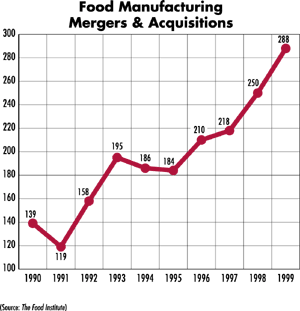
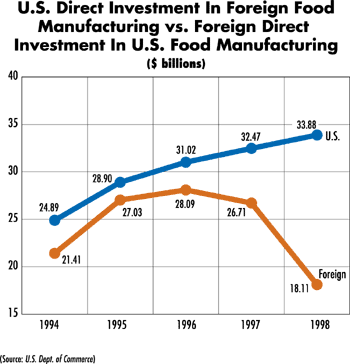
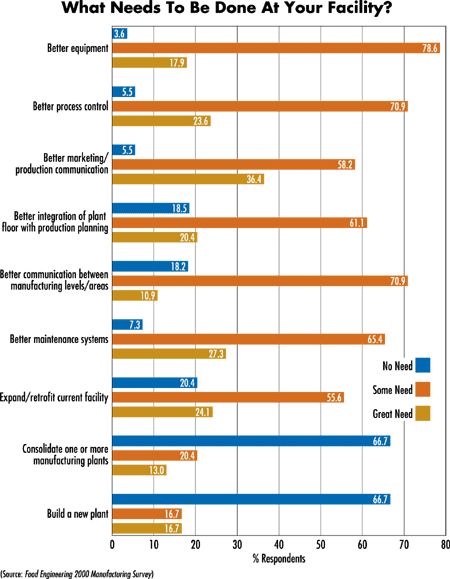
"Larger customers mean larger orders but also lower margins," observes one food-manufacturing executive on Food Engineering's Executive Advisory Panel. "We need to compensate to rebuild margin strengths." Adds a process engineer at a relatively small processed-meats company: "Consolidation of the whole supply chain -- suppliers, processors and customers -- down to a select few -- and large -- companies is frightening!"
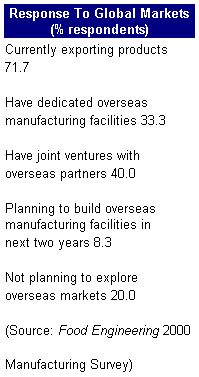
Expansion abroad
As shown on an accompanying graph, U. S. food companies increased their overseas manufacturing investments to a cumulative $33.9 billion by the end of 1998, the latest year for which data is available. According toFood Engineering's 2000 Manufacturing Survey, 3 percent of respondents report that their companies operate their own overseas manufacturing facilities, while 40 percent operate joint ventures with overseas partners. Eight percent plan to build manufacturing facilities overseas within the next two years.Recurrent restructuring
Restructuring is continuous and has become a way of life for food manufacturers, especially as they consolidate operations after acquisitions. ConAgra last year, for example, launched "Operation Overdrive" in an effort to slash $600 million by shutting-down 13 manufacturing plants and 17 smaller facilities while reducing headcount by 7 percent. Sara Lee's "Project 2000," which aims at reducing manufacturing assets to focus on marketing, resulted in the sale or closure of more than 100 facilities and 30 outsourcing agreements by the end of fiscal '99. Following its 1997 "Project Millennia," which closed or divested 25 plants and reduced the workforce by 2,250 to save more than $200 million, H. J. Heinz launched "Operation Excel" which aims at closing or divesting 21 more factories or businesses, expanding or consolidating production at other facilities, and further reducing the workforce by 4,600 to save $240 million.
According to Food Engineering's sister publication Prepared Foods (April, '00), food manufacturers introduced 9,814 new products in 1999, down 11 percent from '98 and 21 percent from '97. The top 20 food manufacturers, however, introduced 13.2 percent of 1999's new products, 18 percent higher than last year "and the first increase we've seen from the top 20 in several years," PF observed. ConAgra and Hormel led the survey with 109 introductions each. Convenient, time-saving meal solutions that taste good "narrowed the gap on restaurant quality," PF added. "After struggling for years with convenient meal solutions, manufacturers finally seem to be getting it."
Production expands
Respondents toFood Engineering's 2000 Manufacturing Survey continue to report improved operating effi ciencies. This year, 74 percent of respondents expect their companies to boost production. Thirty-one percent expect their firms to boost capacity by more than 10 percent; 24 percent envision production boosts of 6 to 10 percent; 19 percent see increases up to 6 percent. Eighteen percent expect production levels to match 1999. Two respondents reported that their plants will shut-down this year.
Food Engineering's 2000 Manufacturing Survey reflects some results similar to FE's Survey of Best Manufacturing Practices (Feb., '00). This year, 178 members of FE's Executive Advisory Panel contributed to our two studies. See accompanying box.

Capital spending dips
Overall capital spending for plant and equipment improvements seems to be slightly down from last year, probably due to the combination of lower profits and higher interest rates.As reported in Food Engineering's 2000 Food Plant Construction Survey (April, '00), new plant and plant-renovation/expansion projects totaled 753 in 1999, down 13 percent from 1998's record 867 projects. As shown on the adjoining table, 68 percent of 1999 construction projects consisted of plant expansions or renovations, up from 64 percent in each of the two prior years.
According to our panelists, capital budgets for plant renovations and expansions will be slightly up this year. About half (52 percent) of our respondents report plant renovation/expansion budgets remaining at 1999 levels, but 32 percent report increased renovation/expansion budgets while only half that many -- 16 percent -- report declines. Eleven percent report renovation/expansion budgets up more than 20 percent; but 14 percent report declines of more than 20 percent. As shown on an accompanying graph, 56 percent of respondents report "some need" and 24 percent "great need" for expanding or retrofitting their plants; only 17 percent see "great need" for building a new plant.
A frozen-food plant manager sees consolidation into "fewer, larger production facilities to lower costs and (improve) efficiency" as a major trend impacting his manufacturing operation over the next few years. On the other hand, a corporate engineer for a major food processor sees the need for "more regional manufacturing" because "the cost of shipping is getting to be a higher percentage due to factory efficiency improvements."
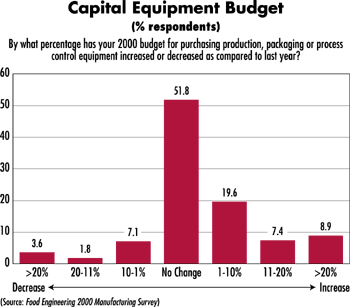
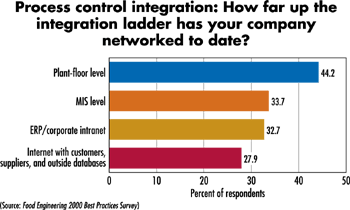
Food Engineering's survey of major publicly-held U.S. food manufacturers projects their capital spending for 2000 down 9 percent from 1999 (see accompanying box).
Integration upgrades
When asked "What needs to be done at your facility?," 71 percent cited "some need" and 24 percent "great need" for better process control. Nearly 70 percent plan to purchase PLCs (the leading hardware category); more than one-third (34 percent) plan to buy SPC software (the leading software category).As reported last February in FE's Best Practices Survey, remarkable improvements have been made during the past year in automating and integrating process controls. Only 42 percent of panelists reported "scattered islands of control" as compared to 56 percent a year earlier. Eight percent reported "top-to-bottom integrated manufacturing," up from just 3 percent in '99.
When asked about their degree of process-control integration, 44 percent report having integrated plant-floor devices, 34 percent have integrated the plant floor with the IT level and 33 percent have integrated to the ERP level. Another 28 percent are using the Internet to integrate with customers, suppliers and outside databases.
Tighter supply chains
Manufacturers are expanding e-commerce activities to better manage their supply chains. J. R. Simplot Co., for example, is developing an Internet channel via an exchange called ecFood.com to integrate with suppliers and customers. "The combination of ecFood.com's expertise in food ingredients, supply-chain processes and Internet technologies -- as well as its neutrality -- provides an opportunity to expand our customer base," said Bill Friend, vice-president for logistics and information services at J. R. Simplot's Food Group. ecFood.com has also established a pilot ingredient-purchase program for Pillsbury.
In addition to e-commerce, survey respondents cite a wide range of methods they are employing to better manage the supply chain, including: reduced inventories of raw materials and finished products; supplier partnerships; more flexible production and packaging equipment; cross docking; carrier partnerships; automated direct-store delivery (DSD); and continuous replenishment (CRP). Survey results for supply-chain improvements closely match those of the Best Practices Survey (see FE Feb., '00). For more on Internet exchanges, see the accompanying story.
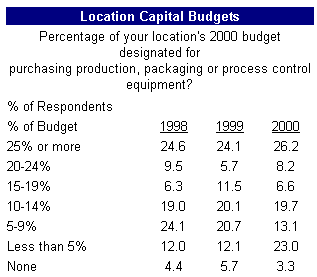
Improved food safety
As reported in the Best Practices Survey, 75 percent of respondent companies have implemented HACCP programs, substantially up from 40 percent in 1998. Especially remarkable are the number of plants implementing HACCP in industry segments where it is not mandated.Ninety percent of respondents in the meat/poultry segment, where HACCP is mandatory, had established HACCP by late 1999. (The remaining 10 percent are presumably very small meat/poultry plants not required to comply with HACCP until Jan. 25 of this year, shortly after Best Practices were surveyed.)
According to USDA's Food Safety & Inspection Service (FSIS), 90 percent of large and 84 percent of small meat/poultry plants have met the agency's Salmonella performance standards since HACCP implementation. FSIS tests raw products for Salmonella contamination to measure that leading cause of foodborne illness as well as plant sanitation. (Plants are required to conduct their own tests for E. coli.) As of Jan. 24, FSIS raw-product tests showed Salmonella down 48.5 percent on broilers, 22.6 percent on ground beef, 30.7 percent on ground turkey and 49.4 percent on hog carcasses. Except for hogs, tests conducted on raw products in small plants after one year of mandated compliance also show downward trends.

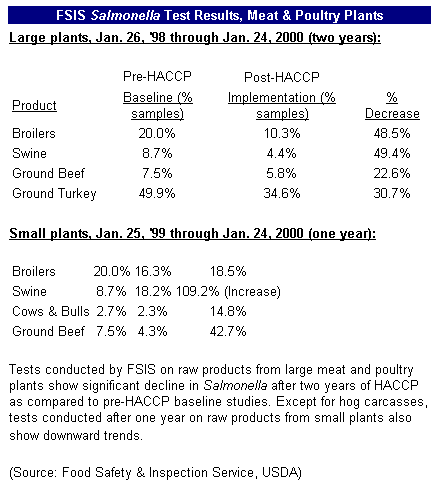
Teams & outsources
Most panelists report improved workforce designs and various outsourced services to more efficiently employ fewer people. Twenty-seven percent report that their companies have reduced engineering or operations staffs.Forty-two percent report that their companies have organized continuous-improvement or cost-reduction teams; 27 percent have organized multi-disciplinary product-development teams; 30 percent have project-engineering teams. On the plant floor, 31 percent employ self-directed work teams and 30 percent management-directed or "shared-leadership" teams. Five percent partner with unions in plant management. Thirty-four percent, however, report no change in traditional "command and control" management systems.
Our Manufacturing Survey computed the mean percentage of respondents reporting various outsourced services. A mean is a midpoint: Half are above, half below. A mean 30 percent of respondents, for example, report outsourcing engineering services. Mean percentages for other outsourced services: maintenance tasks, 14 percent; cleaning or sanitation services, 13 percent; manufacturing to co-packers, 8 percent; microbiological testing, 37 percent; energy-management services, 6 percent. For a more complete breakdown of outsourcing, see "The Case For Outsourcing" (FE Feb, '00).
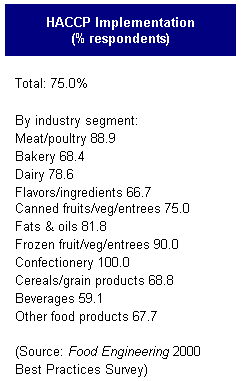
Top trends
FEasked panelists to select one or two trends which they expect to most change their manufacturing operations over the next five years. Responses were wide-ranging, many combining two or more trends into a single response.The largest category of responses relate to automation. "We're moving toward science-based manufacturing," replied a corporate engineer at a cereal company, so "SPC and continuous-improvement programs" will have the most impact. "The move to automation requiring more technical skills and less unskilled workers," said the general supervisor at a fruit/vegetable processing plant. "Labor costs keep increasing even for unskilled workers. Process capability and control to ensure that every product is consistent," adds a corporate engineer at a juice manufacturer. The QA director at a poultry plant forecasts the growth of "smart, computer-driven equipment with voice and sight capabilities."
Food-safety and regulatory issues comprise the second largest group of responses. "Tighter government controls on food safety," says the packaging foreman at meat-processing plant. "GMO-free grain," says the vice-president of an animal-feed company. "Eliminate genetic-modified foods [and] hydrogenated shortnenings," adds the chairman of a bakery firm. "Increasing regulatory pressure will [require us to] devote more resources to validation and slow-down changeovers," observes a manufacturing specialist at a nutritional-products company.
The next largest group of responses relate to flexible manufacturing. The vice-president and general manager of a meat-packing company sees the growth of packaged, case-ready meats improving margins as compared to primal cuts. A bakery vice-president cites "more product variety -- every customer wants 'signature' items." A packaging engineer at a large agribusiness firm relates flexible manufacturing to asset utilization and employee training: "Flexible manufacturing and a reduced asset base will require more highly skilled employees for effective changeovers and quick ramp-up to full production." A turkey plant manager, however, reports that "to improve efficiency, we are going to longer runs of fewer products, actually becoming less flexible."
Additional trends that will most change manufacturing in the near future: "E-commerce, to broaden distribution," says a project engineer at a confectionery plant. "Deregulation of electrical companies," observes the chairman of a frozen-foods company. "Outsourcing to co-packers," says a feed-company president. "Ergonomics rules," says the engineering director at an ice-cream company.
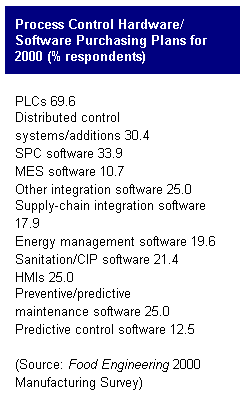
Filling the gap
To round-out our survey, we asked: "Where does your company's manufacturing mission fall short? What's needed to fill the gap?"People and management issues were cited most often. It's clear that many companies are trying to do more with less, and in some cases have either downsized too far or cannot recruit good employees in the current tight labor market. "Need additional employees," "additional technical staff," "properly trained people" and "continued expansion without the workforce to grow with it" were typical responses. An engineering manager at a beverage company sums it all up: "Commitment to people and resources" with "more training, higher pay (and) greater retention of labor."
Automation and integrated information systems ranked second as major needs. "We need better controls to limit variability," says a poultry-plant manager. "Better communication and interface between marketing, R&D and manufacturing operations," says the maintenance manager at a confectionery plant. "Sales forecasting and production planning," adds the agribusiness packaging engineer. "Sales cannot continue to forecast a demand just to meet their targets."
According to an Illinois plant manager, "better process controls and production planning" are needed "to keep customers supplied on a JIT basis. Little or no lead time and a company philosophy of minimal finished goods on inventory make this almost impossible."
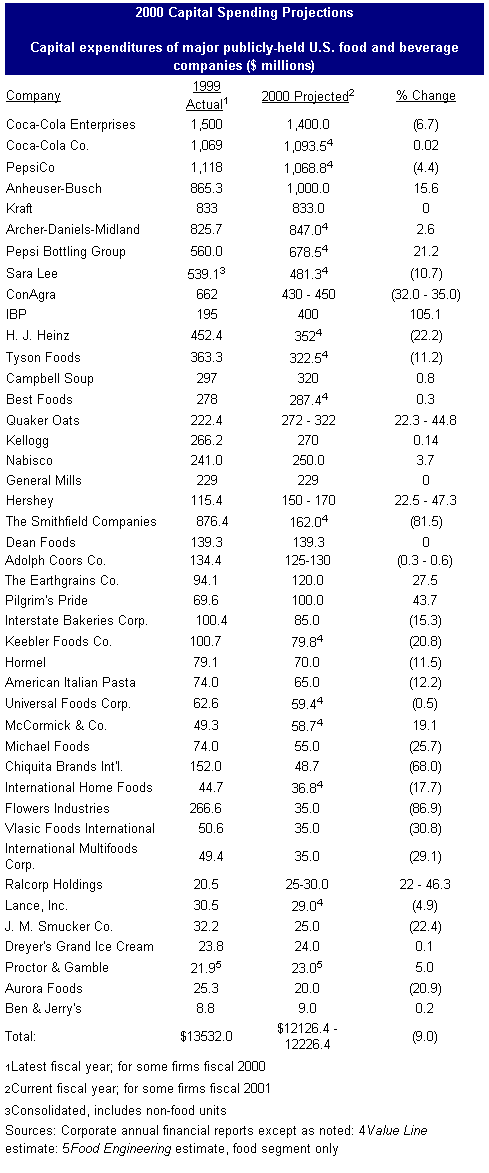
The Q/A supervisor at a frozen-foods plant seems either very flexible or resigned to chaos: "The mission is whatever the day brings," he says.

Sidebar: Should You Use an Internet Exchange?
By: Bill Friend, Vice President, Supply Chain Management & Information Systems, J. R. Simplot Company Food Group, Boise, ID and Olin Thompson, Managing Partner, Process ERP Partners LLC, Providence, R.I.Savings of 3 percent on sugar, 4 percent on cheese, 7 percent on liquid eggs and 30 percent on packaging labels are claimed by Internet exchanges and supported by their food-industry customers.
The list of Internet exchanges grows weekly. Many claim to offer savings opportunities. To understand the exchange landscape, we've categorized food-related Internet sites.
Agri-source sites deal with agricultural products, usually within tightly-defined categories. Examples include www.gofish.com specializing in seafood, and www.efruitinternational.com specializing in fruit and juice products. Sites such as www.walnutex.com and www.sugaronline.com make clear their specialization. Specialized sites may prove excellent for specific products, but they typically can't satisfy 100-percent of your ingredient needs.
A number of sites handle buying and selling general ingredients and packaging materials across the food industry. Examples include www.ecFood.com and www.efdex.com. The ecFood site has been active since June 1999 and has shown good results both in locating alternative sources of supply and in reducing ingredient costs.

Non-food items can be purchased through sites dealing in MRO (maintenance, repair and operations) items, office supplies, transportation, advertising and other areas. Non-food needs are easier to fulfill, since these sites have typically been in business longer.
Should you deal with exchanges? If saving 3 to 5 percent on ingredient costs is important, the answer is "yes." If you want to turn those cost savings into a competitive advantage, you must start now. Many analysts see exchanges quickly impacting the basic cost structure of the industry. Moving late may result in the loss of competitive advantage and have a long-term impact on market share.
Consider getting started as a series of tests, gaining experience as you go. You're building knowledge, not making long-term decisions. Given the wide variety of sites in multiple categories, most food companies will end-up using multiple sites.
Start with some research. Run pilot tests with one or more exchanges in each category. Many sites are built on marketing hype and fancy slide presentations that confuse their plans with results. Look beyond the claims for proof that they can meet your needs.
For agri-sources, look for sites that can demonstrate actual experience meaningful to you. If you buy processed fruit, for example, look for a site that can show you results of actual transactions and can introduce you to other buyers on their site.
For ingredient sites, find out how many transactions they conduct per month. Get examples of actual trades in a variety of ingredient and packaging areas. Does the site adequately support your specifications and regulatory needs? Talk to their customers.
Not all procurement operations are eager to embrace Internet exchanges. The most successful tests we've seen were led by the finance department with the actual work performed by procurement people.
Since this is a pilot test, you can defer decisions conerning procurement strategy and ERP integration until you gain more experience. In the longer term, Internet procurement strategies will need to integrate purchasing, manufacturing and R&D functions.